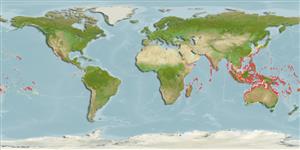>
Gobiiformes (Gobies) >
Gobiidae (Gobies) > Gobiinae
Etymology: Oplopomus: Greek, hoplon = weapon + Greek,poma, -atos = cover, operculum (Ref. 45335).
More on author: Valenciennes.
Environment: milieu / climate zone / depth range / distribution range
Ecologia
marino associati a barriera corallina; distribuzione batimetrica 1 - 30 m (Ref. 1602), usually 1 - 20 m (Ref. 27115). Tropical; 22°C - 29°C (Ref. 27115)
Indo-Pacific: East Africa to the Society Islands, north to the Ryukyu Islands (Ref. 559).
Size / Peso / Age
Maturity: Lm ? range ? - ? cm
Max length : 10.0 cm SL maschio/sesso non determinato; (Ref. 48637)
Short description
Chiavi di identificazione | Morfologia | Morfometria
Spine dorsali (totale) : 7; Raggi dorsali molli (totale) : 10; Spine anali: 1; Raggi anali molli: 10. Males with more intense blue spots on the head and more colorful markings on fins than females; subadults lack the blue and yellow spotting but have more black spots (Ref. 1602); characterized further by having forth and fifth dorsal spines prolonged in male and may have filamentous tips; strong and sharp tipped first spine of each dorsal fin; united pelvic fins, well developed frenum present; rounded caudal fin, shorter than head length; longitudinal scale series 29-30; predorsal scales about 13; mainly ctenoid scales on body; cycloid scales on prepectoral area, breast and abdomen; preopercular margin just above angle with 1-3 small spines; depth of body 4.0-4.6 in SL (Ref. 90102).
Inhabits silty bottoms of inner lagoons and bays (Ref. 9710). Solitary or in pairs (Ref. 90102). Also occurred in shallow to deep coastal sand and mud flats, usually on the sand near large depression with burrow in the middle (Ref. 48637).
Life cycle and mating behavior
Maturities | Riproduzione | Spawnings | Egg(s) | Fecundities | Larve
Randall, J.E., G.R. Allen and R.C. Steene, 1990. Fishes of the Great Barrier Reef and Coral Sea. University of Hawaii Press, Honolulu, Hawaii. 506 p. (Ref. 2334)
IUCN Red List Status (Ref. 130435)
Threat to humans
Harmless
Human uses
Fatal error: Uncaught mysqli_sql_exception: Too many connections in /var/www/html/includes/func_getlabel.php:46
Stack trace:
#0 /var/www/html/includes/func_getlabel.php(46): mysqli->__construct()
#1 /var/www/html/includes/speciessummary.lib.php(318): getlabel()
#2 /var/www/html/summary/SpeciesSummary.php(1315): importance()
#3 {main}
thrown in /var/www/html/includes/func_getlabel.php on line 46
